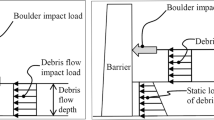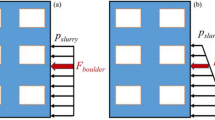Abstract
It’s very important to simulate impact load of debris flow effectively and to investigate dynamic response of architectures under dynamic impact of debris flow, which are necessary to design disaster mitigation construction. Firstly, reinforced concrete domestic architectures in mountain areas of western China had been chosen as main architecture style. The bearing load style and the destructed shape of reinforced framed construction impacted by discontinuous viscous debris flow were studied systematically. Secondly, Jiangjia Ravine debris flow valley in Yunnan Province, China had been chosen as research region. Utilizing based data from fieldwork and practical survey, the authors simulated and calculated theoretically impact force of discontinuous viscous debris flow. Thirdly, an impact data collecting system (IMHE IDCS) was designed and developed to fulfill designed simulation experiments. Finally, a series of impact test of researched structure models had been fulfilled. During experiment, the destructed shape and course of models were observed and the dynamic displacement data and main natural frequency data of models were collected and analyzed.
Similar content being viewed by others
References
Institute of Mountain Hazards and Environment, CAS. Debris Flow in China[M]. Beijing: The Commercial Press, 2000 (Ch).
Wu Jishan, Kang Zhicheng, Tian Lianquan, et al. Debris Flow Observation and Research in Jiangjiagou Yunnan [M]. Beijing: Science Press, 1990: 141–149(Ch).
Scotton P, Deganutti, Andrea M. Phreatic Line and dynamic Impact in Laboratory Debris Flow Experiments[C]// International Conference on Debris-Flow Hazards Mitigation: Mechanics, Prediction, and Assessment, Proceedings, 1997, 1: 777–786.
Douglas H, Zhang S C, MacArthur, et al. Debris Flow Velocity Estimation Methods for Natural Hazard Assessment[J]. Proceedings — National Conference on Hydraulic Engineering, 1993, 1:334–339.
Montrasio L, Valentino R. Experimental and Numerical Analysis of Impact Forces on Structures Due to a Granular Flow[J]. Management Information Systems, 2004, (9): 267–276.
Zanchetta G, Sulpizio R, Pareschi M T, et al. Characteristics of May 5–6, 1998 Volcaniclastic Debris Flows in the Sarno Area (Campania, Southern Italy): Relationships to Structural Damage and Hazard Zonation[J]. Journal of Volcanology and Geothermal Research, 2004, 133(1–4): 377–393.
Slosson J E, Shuirman G, Yoakum D. Responsibility/Liability Related to Mudflows/debris Flows[M]. New York: ASCE, 1986: 235–243.
Wei Hong. Experiment Research of Impact of Debris Flow Head on Dam[J]. China Railway Science, 1996, 17(3): 50–62 (Ch).
Shen Shouchang, Li Leiji, Wei Hong. Experiments on the Surge of Un-coherent Debris Flow[J]. China Railway Science, 1996, 17(3): 42–49(Ch).
Liu Leiji, Wei Hong. Study of Impact of Debris Flow[J]. Journal of Sichuan Union University (Engineering Science Edition), 1997, 1(2): 99–102(Ch).
Wang Zhaoyin. Experiment Study on Debris Flow Head and the Energy Theory [J]. Journal of Hydraulic Engineering, 2001, (3): 18–26 (Ch).
Spang R M, Castaneda S H, Comez E M. Hurricane Paulineits Impact on Acapulco and Subsequent Debris Flows Prevention Measures[C]//Debris-Flow Hazards Mitigitation: Mechanics, Prediction, and Assessment. Proceedings 3rd International DFHM Conference, 2003, 3: 1013–1024.
Zhang Yu, Wei F Q, Wang Q. Impact Force Calculation of Viscous Debris Flow Based Momentum Conservation [J]. Journal of Sediment Research, 2006, (3): 24–27 (Ch).
Zhang Yu, Wei F Q, Jia Songwei, et al. Experimental Research of Unreinforced Masonry Wall under Dynamic Impact of Debris Flow[J]. Journal of Mountain Science, 2006, 24(3): 340–345 (Ch).
Zhang Yi. Fundamental Theory of Concrete Structure [M]. Beijing: Chinese Architectural Industry Press, 2000:347–354 (Ch).
Zhang Yu, Wei F Q, Liu B. IMHE CIPS-Crack Identifying and Processing System in Structure Experiment and Construction Monitoring[J]. World Sci-Tech R&D, 2006, (1): 62–65 (Ch).
The Standard of Peoples Republic of China. Concrete Structure Design Code (GB50010-2002) [M]. Beijing: Chinese Architectural Industry Press, 2002:9–197 (Ch).
The Standard of Peoples Republic of China. Structure Load Design Code (GB500009-2001) [M]. Beijing: Chinese Architectural Industry Press, 2002: 6–12(Ch).
Author information
Authors and Affiliations
Additional information
Foundation item: Supported by the National Natural Science Foundation of China (40201009 and 90201007) and Institute of Mountain Hazards and Environment, Chinese Academy of Sciences
Biography: ZHANG Yu(1970–), female, Associate professor, Ph.D., research direction: dynamics of debris flow and mountain hazards controlling engineering.
Rights and permissions
About this article
Cite this article
Zhang, Y., Fangqiang, W. & Qing, W. Experimental research of reinforced concrete buildings struck by debris flow in mountain areas of western China. Wuhan Univ. J. of Nat. Sci. 12, 645–650 (2007). https://doi.org/10.1007/s11859-006-0339-z
Received:
Issue Date:
DOI: https://doi.org/10.1007/s11859-006-0339-z




